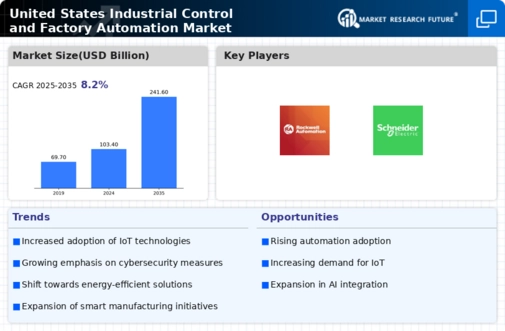Focus on Sustainability
Sustainability is increasingly becoming a focal point within the Global United States Industrial Control and Factory Automation Market Industry. Companies are adopting automation solutions that not only improve efficiency but also reduce environmental impact. For instance, energy-efficient systems and waste reduction technologies are gaining traction as organizations strive to meet regulatory requirements and consumer expectations. This shift towards sustainable practices is likely to drive market growth, as businesses recognize the long-term benefits of integrating eco-friendly solutions into their operations, thereby enhancing their competitiveness in a global market.
Market Growth Projections
The Global United States Industrial Control and Factory Automation Market Industry is poised for substantial growth, with projections indicating a market size of 250 USD Billion in 2024 and an anticipated increase to 450 USD Billion by 2035. This growth trajectory suggests a compound annual growth rate of 5.49% from 2025 to 2035, reflecting the increasing adoption of automation technologies across various sectors. The market's expansion is likely driven by factors such as technological advancements, rising demand for automation, and government support initiatives, positioning it as a critical component of the broader industrial landscape.
Technological Advancements
The Global United States Industrial Control and Factory Automation Market Industry is propelled by rapid technological advancements. Innovations in artificial intelligence, machine learning, and the Internet of Things are enhancing automation capabilities. For instance, the integration of AI in manufacturing processes allows for predictive maintenance, reducing downtime and operational costs. As a result, the market is projected to reach 250 USD Billion in 2024, reflecting the growing demand for smart manufacturing solutions. Companies are increasingly adopting these technologies to improve efficiency and productivity, suggesting a robust growth trajectory in the coming years.
Rising Demand for Automation
The Global United States Industrial Control and Factory Automation Market Industry experiences a surge in demand for automation across various sectors. Industries such as automotive, pharmaceuticals, and food processing are increasingly automating their operations to enhance productivity and reduce labor costs. This trend is evidenced by the projected market growth to 450 USD Billion by 2035, driven by the need for efficient production processes. Automation not only streamlines operations but also improves product quality and consistency, making it a vital component for businesses aiming to remain competitive in a globalized market.
Government Initiatives and Support
Government initiatives play a crucial role in shaping the Global United States Industrial Control and Factory Automation Market Industry. Various federal and state programs are designed to promote advanced manufacturing technologies and automation. For example, initiatives aimed at fostering innovation and providing funding for research and development are likely to stimulate market growth. These efforts may contribute to the anticipated compound annual growth rate of 5.49% from 2025 to 2035, as businesses leverage government support to adopt cutting-edge technologies and enhance their operational capabilities.
Integration of Cybersecurity Measures
The integration of robust cybersecurity measures is becoming essential within the Global United States Industrial Control and Factory Automation Market Industry. As industrial systems become more interconnected, the risk of cyber threats increases, prompting companies to invest in advanced security solutions. This trend is indicative of a broader recognition of the importance of safeguarding operational technology. By prioritizing cybersecurity, organizations can protect their assets and ensure uninterrupted operations, which is crucial for maintaining competitiveness in an increasingly digital landscape. This focus on security may further bolster market growth as businesses seek to mitigate risks associated with automation.













Leave a Comment